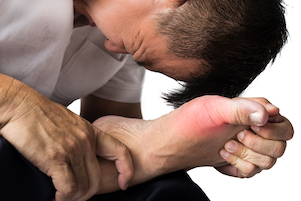7 Secrets to Reduce Gout Pain
If you are an existing Real Time Pain Relief Retail Customer, simply activate your account by resetting your password on the NEW SITE, Click Here!
7 Secrets to Reduce Gout Pain
Dealing with pain from gout? You are not alone! Here are 7 ways to help you get some relief.
Gout is an inflammatory condition that usually affects the joints. It can develop when the level of uric acid in the blood becomes too high. Severe pain develops when the uric acid starts forming crystals in the joint.
Symptoms of Gout
According to the Arthritis Foundation, about eight million people in the United States have gout. Symptoms of gout often affect the joints of the feet, but any joint can be affected, including the knees, wrists, and fingers.
Symptoms may include:
- Severe pain in the affected joint
- Decreased range of motion
- Inflammation in the joint
- Redness and warmth in the affected joint
The symptoms of gout typically last for about three to ten days after treatment starts. According to the Mayo Clinic, the pain is often most severe in the first 12 hours. Some people that develop gout have repeated flare-ups. It’s essential to talk with your doctor if you have repeated gout attacks. Over time, the increased uric acid may lead to joint damage.
Although it can vary, gout typically affects one joint at a time. If the condition is not properly treated, additional joints may be affected. Untreated gout can lead to the development of lumps of crystallized uric acid around the joints under the skin.
Risk Factors for Gout
Anyone can develop gout if uric acid builds up in their body. But certain factors may put you at an increased risk of developing the condition. For example, kidney disease and thyroid problems can interfere with the body’s ability to excrete uric acid, which raises your chances of gout.
Other risk factors for developing gout include drinking large amounts of soda and being obese. Gout also appears to run in families. If you have a close relative, such as a parent or sibling, that had gout, it increases your risk. Having high blood pressure, heart disease, and diabetes also increases your chances of developing gout.
Relief Tips for Gout Pain
Some of the gout relief tips below help prevent a build-up of uric acid in the body. But most of the suggestions don’t promote elimination of uric acid. Instead, they treat gout pain and inflammation.
If you develop gout, the pain can be severe. Fortunately, there are several at home tips that may help decrease gout pain and provide relief. Consider the following suggestions:
1) Watch Your Diet
Certain foods that are high in the compound purine can increase uric acid levels in the body and increase a person’s risk of developing gout. If you have gout pain or have had an attack in the past, consider limiting certain types of seafood, such as herring, scallops, and sardines. Meats including veal, turkey, and bacon are also high in purines and should be limited if you have gout.
2) Use a Bath Bomb
A warm bath with a pain-relieving bath bomb can reduce discomfort due to gout. A soak in the tub may not only reduce pain, but it may also relax the joint and decrease stiffness. Look for a bath bombs that contains Arnica Montana as the active ingredient.
3) Elevate Your Foot
The joints of the foot, especially the big toe, is a common site of gout pain. If gout affects your foot, try to elevate it slightly above your heart to decrease swelling. If possible, give your feet a rest and avoid standing for too long or walking long distances until the pain has subsided.
4) Apply an Ice Pack
Applying an ice pack is often a good way to decrease inflammation and pain associated with various joint problems including gout. Although ice will not reduce uric acid levels in the body, it can decrease discomfort. Use a cold washcloth or ice pack three to five times a day applying it for about fifteen minutes each time.
5) Reduce Alcohol Intake
Beer contains purines and can increase the intensity of a gout attack. Not all types of alcohol contain purines, but they can increase the number of purines your body makes, which in turn can raise uric acid levels. If you have gout pain, consider avoiding alcohol until symptoms clear.
6) Drink Plenty of Water
Drinking plenty of water helps flush uric acid out of the body. Staying well hydrated might also decrease your risk of developing kidney stones, which can also occur with high uric acid levels. Try to drink at least eight cups of water a day.
7) Take a Joint Supplement
A joint supplement can be helpful for people that have gout. Joint supplements can reduce pain, improve flexibility, and decrease swelling. Joint supplements also promote overall joint health. The best joint supplements contain ingredients like Boswellia Serrata, Ginger Root Extract, and collagen.
Keep in mind; if you have gout, it’s also important to talk with your doctor about treatment options. In some cases, medication may be prescribed to help you eliminate uric acid from the body or reduce the production of uric acid.
Need alternative ways to get pain relief without taking pills? (Click Here) to learn more!
Here are 4 reasons why you will love topical pain relief! (Click Here) to learn more!
Check out our articles and infographics to learn a multitude of ways to start relieving your pain naturally!
Real Time Pain Relief not only cares about the quality ingredients that go into each and every one of our products – but also about the people who buy them. We hope this blog becomes a valued resource for your own personal journey to better health. For 20 years, Real Time Pain Relief has provided family safe pain relief infused with Nature’s Ingredients. From the useful information in our articles to our high-quality products, we hope you feel better and pass it on!
Sources:
STAY IN TOUCH
We are always available for you. You can call us or submit a support ticket and we will get back to you!
Or, you can check us out on our social media pages. We want to hear from you!
877-787-7180
P.O. Box 798 Cabot, AR 72023




